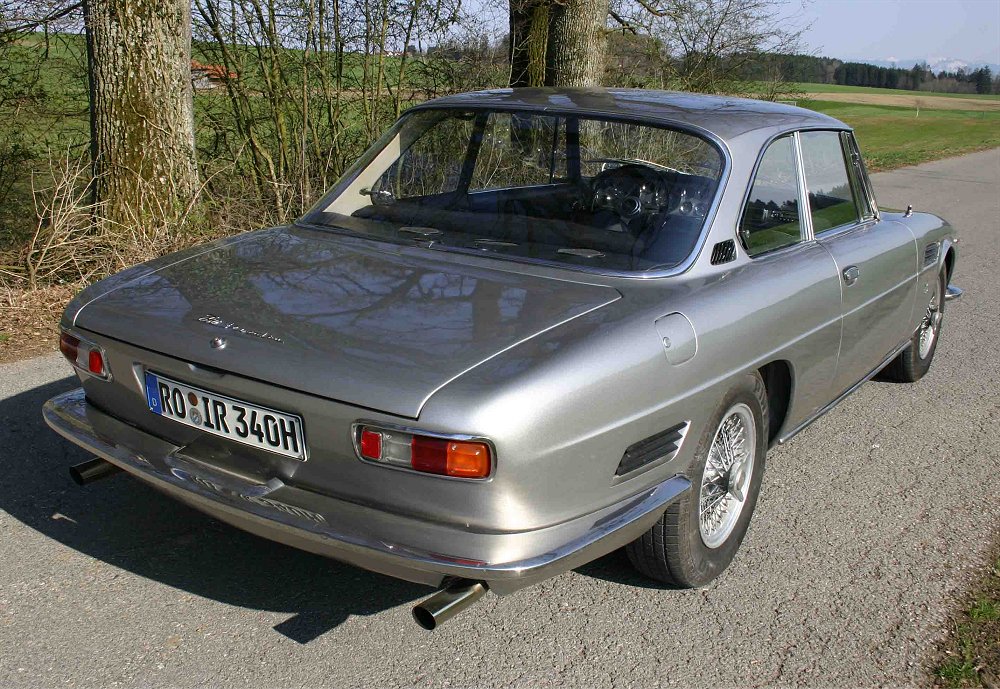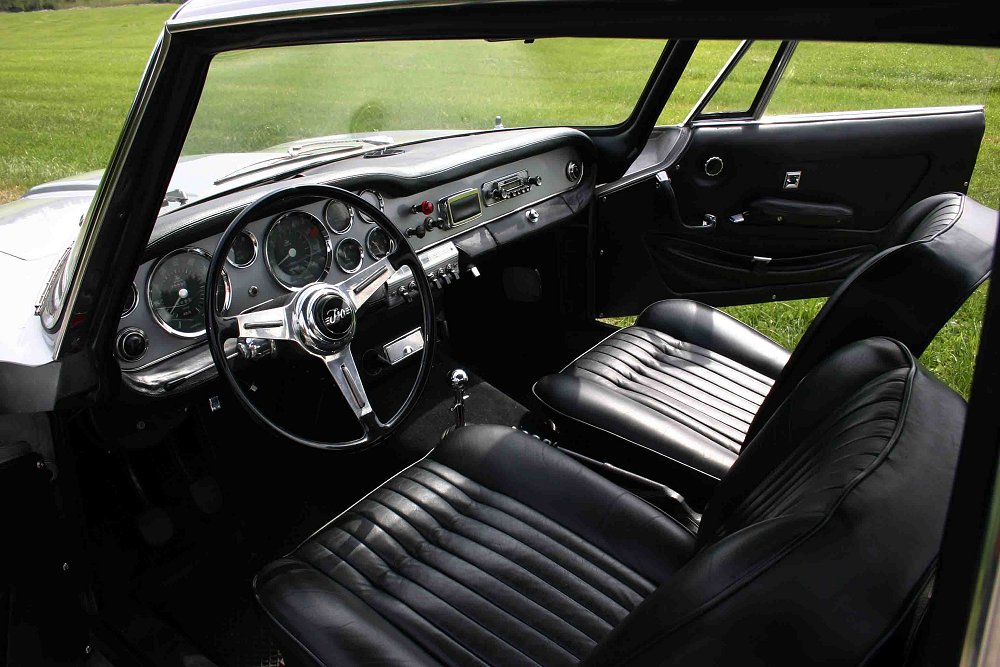Description
The ISO Rivolta IR 340 GT was the more powerful and performance-oriented evolution of ISO Rivolta’s first great grand tourer, the IR 300. Introduced in 1963, just a year after the debut of the original model, the IR 340 took everything that made the 300 such a revelation—its elegant design, superb chassis, and seamless blend of Italian sophistication with American power—and turned the dial up a notch. It offered greater performance, sharper responses, and an even more refined driving experience, reaffirming ISO Rivolta’s place among the finest luxury GT builders of the 1960s.
By the time the IR 340 appeared, ISO had firmly established itself as a small but ambitious manufacturer of hand-built, high-speed touring cars. Renzo Rivolta’s vision for the company was clear: to produce cars that offered the comfort and beauty of Italian design, the engineering integrity of European chassis development, and the reliability and power of American engines. The IR 340 was conceived as a step closer to a true driver’s GT—a car that could match the performance of a Ferrari or Maserati while maintaining the durability and civility that made the IR 300 such a success.
At the heart of the ISO Rivolta IR 340 GT lay an uprated version of the Chevrolet 327 cubic inch (5.4-litre) small-block V8 engine, the same basic unit used in the Corvette but tuned to deliver more power and responsiveness. While the standard IR 300 produced 300 horsepower, the IR 340’s engine was tuned to 340 horsepower—hence the designation “IR 340.” This version featured a higher-compression ratio, improved carburation, and revised exhaust manifolds for better breathing. In typical ISO fashion, the engine remained understressed and supremely reliable, providing vast reserves of torque from low revs. Paired with a four-speed Borg-Warner manual gearbox (or optional GM automatic), the IR 340 could accelerate from 0–100 km/h (62 mph) in under 7 seconds and reach a top speed of approximately 225–230 km/h (140–143 mph).
While the engine gave the IR 340 its prodigious pace, the car’s real brilliance lay beneath the surface—in Giotto Bizzarrini’s chassis. The same pressed-steel monocoque platform and independent suspension layout from the IR 300 were retained, but the suspension geometry and damping were subtly revised to handle the extra power and weight distribution. The front used unequal-length wishbones with coil springs and telescopic dampers, while the rear employed a de Dion axle with twin trailing arms, a Watts linkage, and inboard disc brakes—a layout that gave the car exceptional stability and comfort. Four-wheel disc brakes remained standard, and the car’s weight distribution and rigid chassis made it one of the most balanced GTs of its generation. Contemporary road testers noted its remarkable combination of supple ride quality and precise handling, describing it as “a car that moves as if carved from a single piece of metal.”
Visually, the ISO Rivolta IR 340 GT remained almost identical to the IR 300. Giorgetto Giugiaro’s design, executed by Bertone, was so pure and proportionally perfect that ISO saw no need for change. The car retained its long bonnet, pillarless greenhouse, and short rear deck—classic grand tourer proportions rendered with Italian restraint. Subtle differences, such as revised badging and minor trim adjustments, distinguished the 340 from its predecessor, while new colour options added to its exclusivity. The front fascia continued to feature twin headlamps framing a slim horizontal grille, while the flanks were defined by a clean, unbroken beltline and beautifully sculpted wheelarches. With its understated elegance, the IR 340 exuded quiet confidence rather than ostentation—a true gentleman’s express rather than a racing car for the road.
Inside, the IR 340 GT offered the same beautifully appointed cabin that had made the IR 300 such a delight. Every element reflected ISO’s commitment to quality and craftsmanship: hand-stitched leather upholstery, polished wood fascia, chrome-bezelled Veglia instruments, and deep-pile carpeting. The cockpit layout was simple, functional, and deeply satisfying, with large, legible gauges and a wood-rimmed steering wheel set at just the right angle. The car could seat four occupants in comfort, with generous space for luggage—making it a genuine grand tourer rather than a sports car masquerading as one. Optional extras included air conditioning, power windows, and a Becker radio, all of which could be specified to order.
On the road, the ISO Rivolta IR 340 GT was a masterpiece of composure. The engine’s deep, even rumble provided effortless acceleration, and the immense torque meant that the car could be driven lazily in higher gears or pushed hard for thrilling performance. The steering was precise and communicative, and the suspension soaked up rough surfaces while maintaining taut control through bends. The de Dion rear axle kept the car poised even when accelerating hard on uneven roads, while the powerful disc brakes gave confidence at speed. It was the ideal car for covering long distances across Europe—fast, serene, and endlessly capable.
For many contemporary reviewers, the IR 340 GT represented the sweet spot in ISO’s range. It combined the elegance and usability of the IR 300 with a sharper, more engaging character, without the later Grifo’s overt sportiness. Owners could drive it daily, yet still experience the thrill of a true high-performance GT when the road opened up. It was a car that rewarded both restraint and enthusiasm—a testament to ISO’s engineering philosophy that performance and civility need not be opposites.
Production numbers for the IR 340 GT were modest, as ISO was a boutique manufacturer hand-assembling each car in its Bresso, Milan factory. Estimates suggest that only a few hundred examples were built between 1963 and 1967 before the focus shifted toward the more aggressive Grifo and the four-door Fidia. Yet the IR 340’s importance cannot be overstated: it bridged the gap between the refined touring nature of the IR 300 and the pure sports-car aggression of the Grifo, establishing ISO as a genuine rival to the great Italian marques.
Today, the ISO Rivolta IR 340 GT is highly prized among collectors for its rarity, balance, and usability. Its Giugiaro styling remains timeless, its Bizzarrini chassis still feels astonishingly modern, and its Corvette-sourced V8 provides effortless power with a glorious soundtrack. Few cars of the 1960s combine such performance and practicality with this level of elegance and craftsmanship.
The ISO Rivolta IR 340 GT was, in many ways, the definitive expression of Renzo Rivolta’s vision: an Italian grand tourer with the soul of a craftsman and the heart of an American powerhouse. It offered everything that made ISO special—style, engineering brilliance, and the ability to cross continents with grace and speed. To this day, it stands as one of the great unsung masterpieces of the golden age of grand touring.

